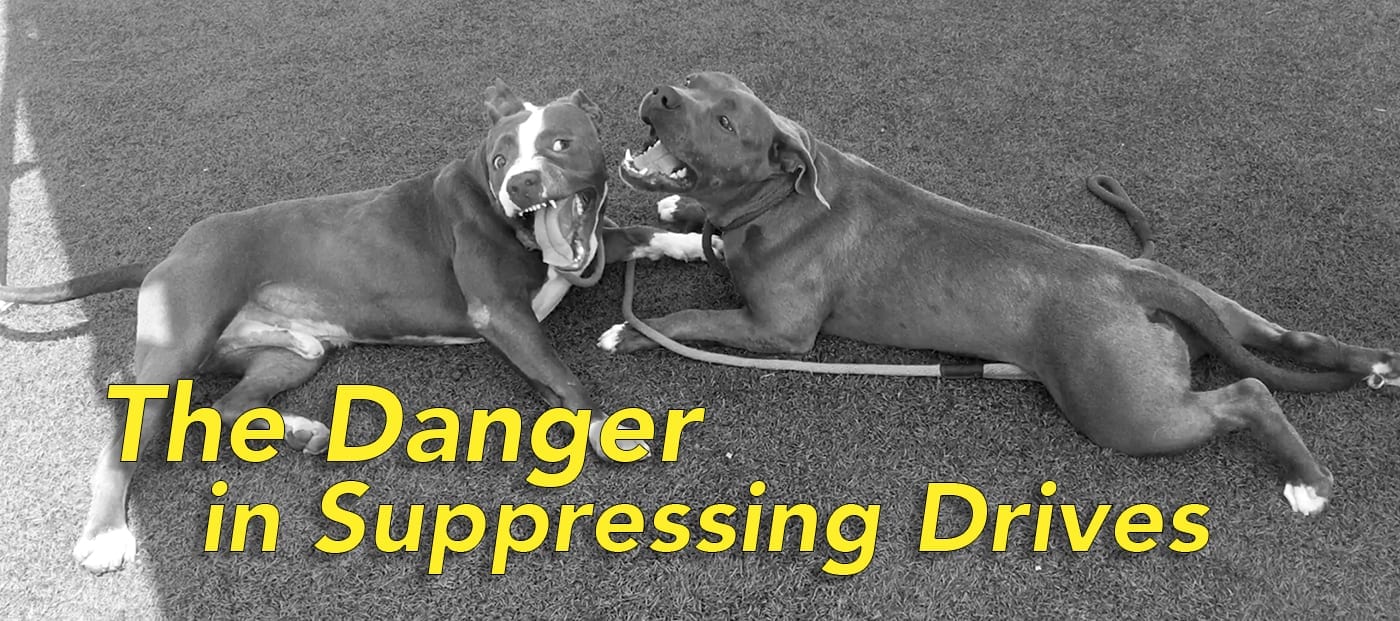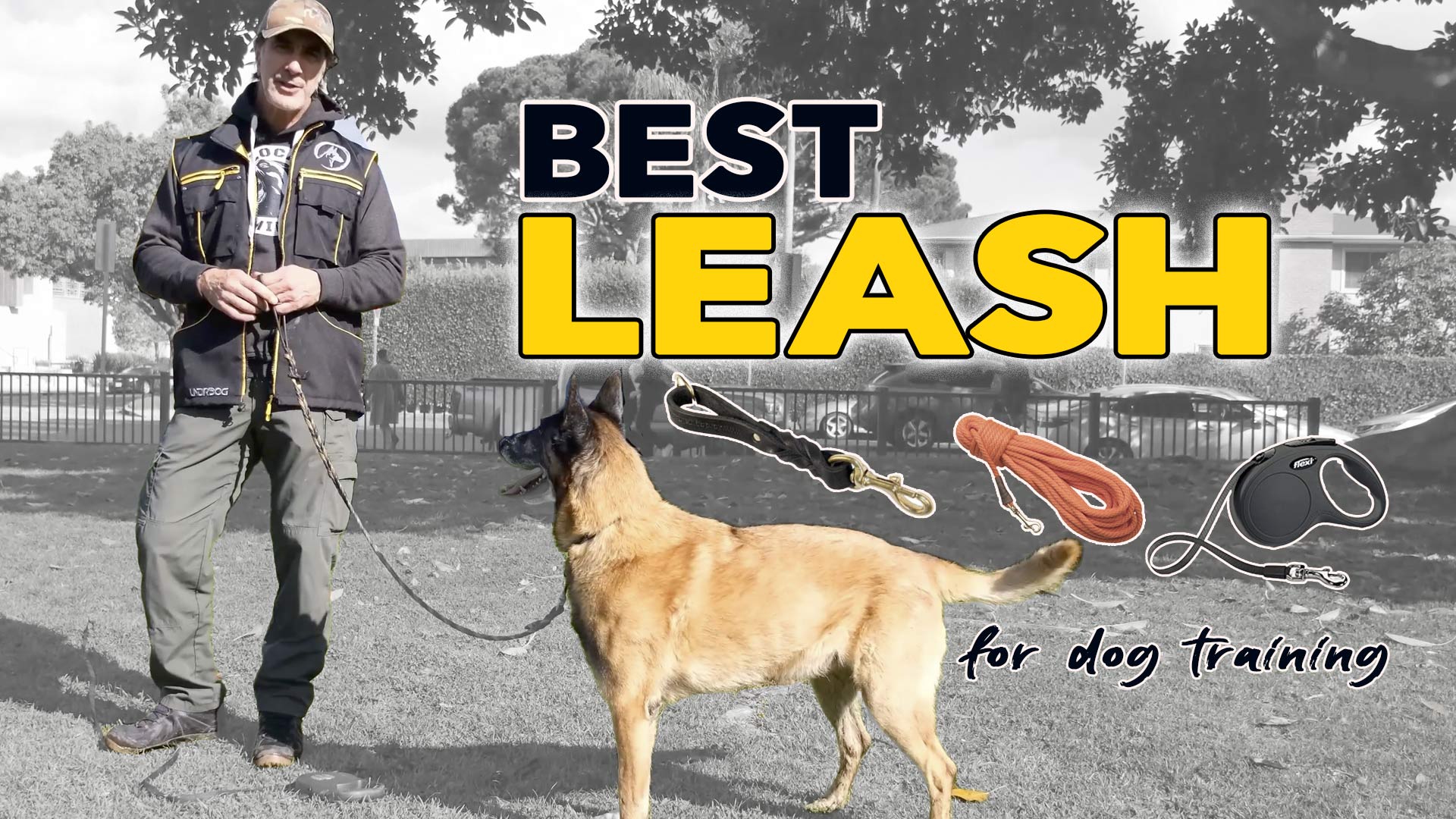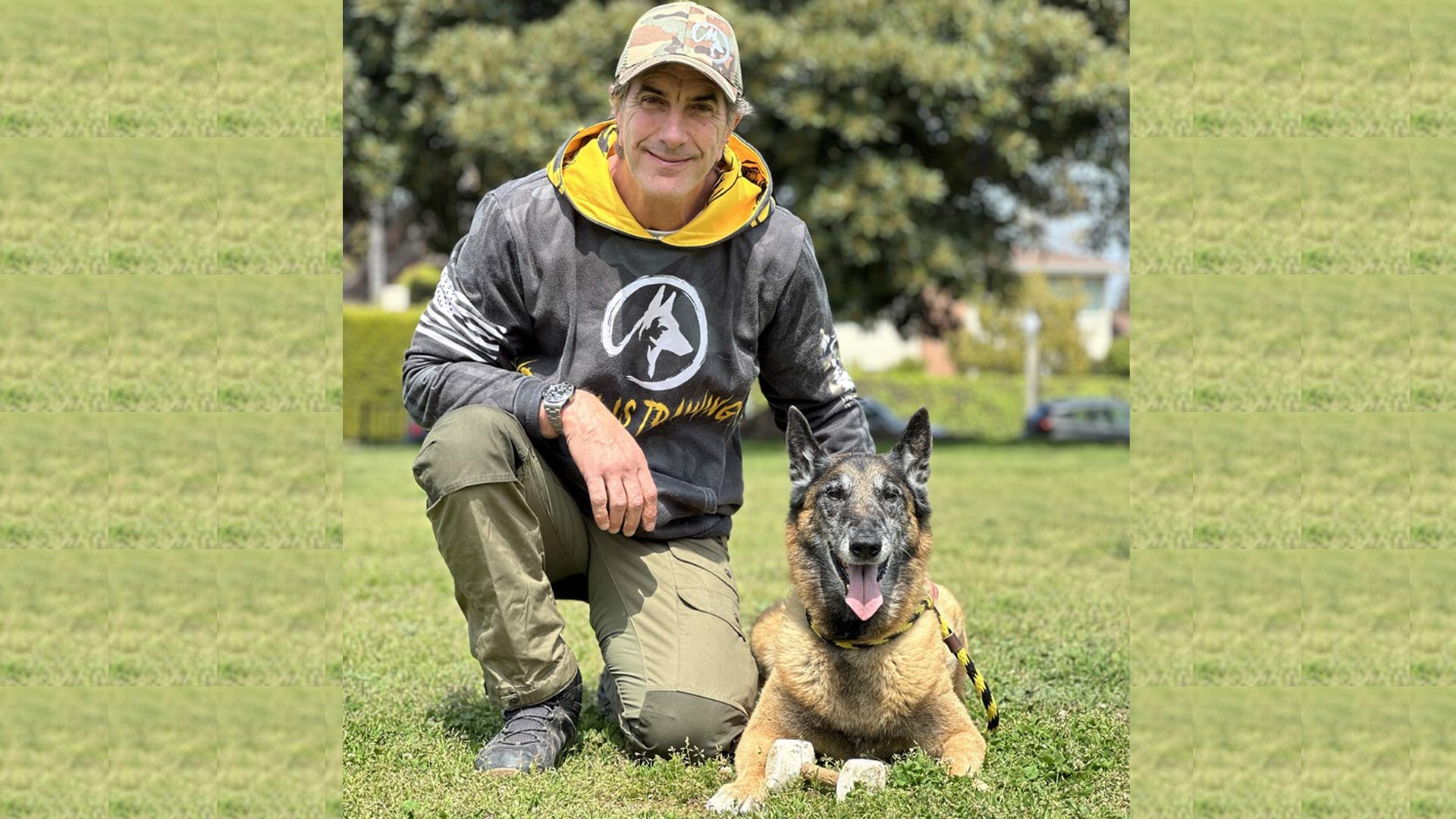The information contained in this article may be a bit advanced for some readers, but it is extremely important if you are dealing with a dog with difficult behaviors and are looking to hire a trainer to work with your dog or you are working with the dog yourself. Suppressing the drives of a dog may seem like the answer on the surface, but there is much to be understood. This may also not be a piece that will find favor among all trainers.
With so many trainers popping up all over the Internet, it can leave you confused as whom to hire. So many great websites, slick videos and a million promises guarantying you (and your dog) success. Everyone is a specialist in aggression and problem solving now-a-days. But how they go about solving these problems might not be a logical or proper solution when you look at it from the point of view of the dog. Furthermore, aggression in dogs is never “FIXED or CURED” it is merely put in a place that allows us to manage it. I’ve worked with countless aggression cases and always express to the client that the dog is under a strict management plan and it must be managed and maintained. I’ll write more about that issue later.
See: online dog training
Since the main issue that most pet dogs face is problem solving (and not training), most trainers have made a really good living by being NO-Men (or women). Let’s consider that most of the trainers that we see, including those on TV, have never titled a dog or really trained a dog, they’ve merely stopped dogs from doing unwanted behaviors – they are suppressing the drives of the dog. That is they STOP the dog from doing that what the owner doesn’t want to dog to do: be that jumping on strangers, killing the cat, lunging at another dog, chewing up shoes, pulling on the leash or a host of other things. Many trainers use aversion to block these behaviors such as e-collars, pinch collars and the like. I’ll start out by saying that there is nothing wrong with these tools when they are properly used, sadly though they are often not used properly.
***Not that pet dog owners need real trainers, but understand that trainers train dogs to do behaviors (which is more than blocking unwanted behaviors). Take a look at trainers who train and title dogs in AKC Obedience, protection dog sports, scent detection, agility, search and rescue and more.
Before we examine the issue at hand, let’s look at a dog’s behavior / drive like a water filled balloon: If you squeeze on one side of the balloon, the water goes to the other side, and if you hold and squeeze there, the water will flow to yet another part of the balloon. You see, interestingly enough, the water never goes away, and that is what people don’t understand about the behavior of the dog. The behavior, unless properly addressed in the whole dog, will merely leak out into another place in the dog’s drives. A great example in competitive dogs are dogs that whine and whimper when they approach a trial field, agility course or get close to biting the bad guy. Because we don’t let them go run and do what they want, they leak out. This leaking is the suppression of the drive to go run or bite the bad guy and instead they whimper and whine. We fix this by building focusing on obedience and building a relationship with the dog, not by shocking the dog or yanking the dog. In fact, an electric collar or pinch collar will only exacerbate the drive more and will create more of a conflict.
The behavior of the dog is directly related to the drive of the dog, and to understand dogs, you must understand the inherent drives of dogs. Drives are the physical manifestation of the dog’s personality and energy; they are unconscious, biological impulses that carry out important vital functions. How a dog sees and reacts to things such as food, physical presence of other people or dogs, things that move, etc. all fall under the “drive” category.
Drives include prey drives, chase drives, play drives, fight – flight and reproductive drives. Some dogs have higher prey drive; some have strong defensive drives. The drives of a dog can vary as much as the overall appearance of the dog.
We should concern ourselves with the manifestation of these drives and try to identify them in order to better understand the dog and their needs. Understanding the drives of dogs gives us a better picture of their needs and we should strive to understand a dog’s drives when placing them in an environment where their drives will come into play.
Defensive Drive: Almost every component of “drive” can be wrapped up in the defensive drive category. A dog’s drive is highly dependent on survival (life and death / fight of flight). A dog’s decision or reaction to something he sees (or perceives in his mind) determines if he lives or dies. A dog can fight to survive or run to survive, each of these can still be labeled as a defensive drive. Defensive drive can be summarized as a dog’s survival instinct / drive. A dog might choose to become dominant or aggressive as a result of a stimulus (either real or imagined) or he might cower and roll over onto his back; both of these decisions are in his interest to survive. He decides, “If I roll over and play nice I won’t get hurt,” or “I have to kill this threat in order to survive.” This is his defensive drive.
Defensive aggression is a component of the dog’s defensive drive because it is how he responds to the stimulus of pressure or a threat. This is generally seen in a dog that will fight when he feels scared or pressured, be that by another dog or a person. However a dog that rolls over when he feels scared is also exhibiting a defensive drive in an effort to defend himself, it’s just not defensive aggression, it is defensive submission (still in the defensive drive category). These drives are often hard wired into the dog through his DNA, much of which is passed through the bloodlines of the dog and a lot of this comes through the mother. This is why we can often pick a dog that will have a higher degree of fight drive as a puppy only weeks old. And, because this is so hard wired into the dog just like color, head shape and size, it is almost impossible to “cure” or “fix” this issue. It can however be worked with by a qualified trainer, just not in the way most cookie cutter trainers do it.
It is not a quick fix that we’re gonna solve in 4 sessions for $900.
A big problem arises when a person / trainer pushes the dog into a behavior that the dog is not comfortable with. We see this when people try to alpha roll a dog and get bit in the face by a dog that is not ready to roll over. I’ve always been against the alpha roll, it is silly and dangerous. Also, when people put e-collars or pinch collars on dogs in order to squash aggression or force behaviors this can be another issue. This might work in some dogs, but many of these dogs never had real issues to start with and could have been helped more fairly by first establishing a relationship with them. Properly used, a correction is used to block a negative behavior and bring the dog’s focus back to us. It is not uncommon for corrections improperly used to over stimulate a dog and create more negative behaviors and increasing the dog’s aggression or even creating aggression in a dog that just had a suspicion. Many times when teaching playgroup training I’ve seen people correct for behaviors that were not aggressive at all or were not at risk of becoming aggression. Done too often this can make a dog aggressive because of the frustration it creates in the dog’s mind. As I said before, corrections should block negative behaviors and bring the dog’s attention back to the handler or calm the dog down, never frustrate or excite the dog.
When shocking or jerking a dog to suppress drives instead of training for behaviors you are putting a dog in a situation for inevitable failure. This failure can be an imbalanced relationship with his human or a dog that will see the world as an unfair place and may be likely to act out when least expected. This does a great disservice to dogs, just like putting a muzzle on a fearful dog and introducing him into a group of dogs that he is uncomfortable with. When these drives (in particular fight drives) are suppressed they go somewhere. If properly approached, we channel them to obedience or desired behaviors, if improperly approached we try to turn them off like dousing a fire, sadly this approach is like trying to douse a fire with gasoline.
If a dog has a misplaced drive for aggression it is important to start out by developing a relationship with the dog and teaching him things he should do. I have always encouraged people to “NOT tell their dogs NOT to do something,” instead tell them “TO DO something.” Case in point, a protection sport dog that is biting the bad guy: we don’t tell him to STOP biting, we tell him OUT. We don’t tell him to STOP barking, we tell him to SIT. We use obedience to channel the drive into another behavior. It is through the obedience that we deliver the reward. He lets go of the sleeve (or OUTs) and we give him another bite. At the end we give him a bite on a tug. There is a series of rewards that lead the dog into compliance. And compliance is a happy, well-balanced state of mind.
Excitement, frustration and anger are not ways to counter aggression, control is. The dog must know that you are in control. We teach this to the dog through enforcing obedience. We ask him to do something, he does it he gets rewarded, he doesn’t we correct him until he complies and THEN we reward him. We have his best interest at heart. There is an old German saying: Even a mouse cornered will bite. And this holds true for most dogs. Most dogs will go to a far degree of accepting bad behaviors, but pushed too far, they will bite. And those dogs that take it for a long time are often those that bite with a vengeance when they do bite. I’ve seen this in dogs that were trained unfairly with e-collars and pressure. These dogs just need to know who’s holding the remote and they will bite to get the pressure to stop.
Since most pet dogs have pretty soft drives, we have to understand that suppressing the drives of these dogs often does them a great disservice. It puts them in a place to fail and inevitably they will. If you have a dog that is leash reactive and you strap an e-collar on him and shock him every time he lunges at the other dog, he is forming a simple association between his fear of the other dog and the pain and pressure he’s feeling from the collar. When he assimilates these two things, he will start to really hate the other dog or fear him more.
“I’m afraid of the dog, I bark at that dog, that dog causes me to get shocked – I HATE THAT DOG!”
Properly handled, the dog should be made to understand obedience, which comes through me! I tell you to SIT, if you sit you get a reward. If you don’t sit, I CORRECT you. I might do that with a slip lead, a pinch collar or an e-collar – but I CORRECT YOU. This takes the other dog out of the equation. Most people just turn up the power on the e-collar and keep going. Although this method is used in rattlesnake aversion training, it is not a good plan for dogs that show issues with other dogs.
It is critical to understand the how’s and why’s of dog behavior before we try to “Fix” them. It is imperative to understand that if we take this behavior from a dog and try to suppress it or squash it, it has to go somewhere. And where it might go might not be a desirable place. Managing behaviors is not a quick fix; it is a lifelong process and should be dealt with accordingly.
Dogs are simple creatures but are complex at the same time. They are not turnkey robots. They experience emotions, fears, feelings, happiness, pain, pleasure, anger and sadness –just as humans do.
When approaching canine behaviors, start out understanding that the solution to the issue lies with the dog’s relationship with his human, not with the trainer. Search out a trainer that is skilled at working with dogs in a fair and balanced way. This is often tough, but referrals are the best way to go. If the trainer has dealt with a similar issue before, he might be your best option. And, most importantly, there are certain behaviors that just can’t be “fixed.” Some issues are so hard wired into the dog that you are stuck with them. It would be more humane to kill the dog than torture him to try and change. These are the rarest of cases, but they do exist. There is no magic technique for any dog training issue; it’s hard work, dedication and persistence.
That is the key to dog training – Patience and Persistence!






